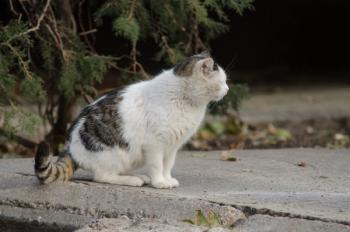
CVC highlight: Ouch! How do you know your feline patient hurts?
Dr. Ilona Rodan gives pointers to identify subtle signs of pain in cats in the hospital-and at home.Recognizing pain and providing needed analgesia have allowed enhanced quality of patient care and improved comfort for our feline patients. But cats don't show signs of pain as other species do-and that makes it more difficult to recognize and assess. Instead, we have to look to changes in an individual cat's behavior to identify pain in the cat.
Recognizing pain and providing needed analgesia have allowed enhanced quality of patient care and improved comfort for our feline patients. But cats don't show signs of pain as other species do-and that makes it more difficult to recognize and assess. Instead, we have to look to changes in an individual cat's behavior to identify pain in the cat.
All team members should be educated to recognize pain, and client education for early pain recognition is critical as well. Here are some ways to determine if a cat is painful during a veterinary visit.
Ask open-ended questions
Because changes in behavior are the most important indicator of chronic pain, client information is essential to recognize the changes that that may be linked to pain. Ask pet owners open-ended questions about changes in their cat's behavior that have occurred since the last visit or during the time period of their concern. For example, ask a client “What changes in behavior have you noticed?” (see the list of behavior changes below).
Tweak your examination
A painful cat may be tense on examination in an attempt to protect itself. Tailor the exam to make it easier for painful and anxious feline patients-instead of starting at the head and working to the tail, examine the nonpainful areas and those that don't arouse the cat first. Reserve areas that a cat may not like touched (e.g. the legs or feet in arthritic cats) until the end of the examination. Watch for abnormal postures, such as an arched back or a hunched body, and facial expressions, like squinting eyes.
Evaluate the gait
Arthritis is extremely common in cats, but it is rare to see a cat limp. Instead, watch for hesitation when a cat jumps up or down and stiffness upon awakening.
Compare pre- and post-procedures
When assessing for pain after a procedure, compare posture and position in the cage post-procedure with what was noted prior to the procedure.
Palpate the wound
Palpating the wound allows us to identify whether analgesia is sufficient. Increased body tension or flinching or reacting with aggression when palpated are frequently seen with insufficient analgesia.
Monitor the response to analgesia
It is important to note that fear or stress can also cause changes in behaviors, often making it difficult to differentiate between fear and pain, especially in the veterinary practice. For example, a cat that “freezes” is signaling that it is fearful, anxious, or uncomfortable. Physiologic signs, such as increased respiration and heart rate, increased blood pressure, or dilated pupils, may also be secondary to pain, stress, or illness.
Even if a cat doesn't express pain, it doesn't mean isn't painful. If there is a question regarding the presence of pain, administer an analgesic and assess the patient response. Response to therapy is an appropriate and important tool in pain assessment.
Prepare for the next visit
Hopefully, the medication you prescribe for a chronic condition will keep a cat comfortable during future visits, but many patients with chronic pain have flare-ups and palpation can be uncomfortable. Buprenorphine sent home for transmucosal use and given approximately 30 minutes prior to the examination can be very helpful for patients that have demonstrated chronic pain during veterinary visits.
Educate your clients
Educate clients to watch for changes in behavior, and contact your hospital if pain is noted. Since cats that are painful often continue to eat and signs of pain are subtle, ask pet owners to put a picture of their cat on the refrigerator or somewhere they can see it frequently. Each year, have them put another picture up. Recommend that when they see a difference, they should contact you.
Changes in normal behaviors associated with pain
Appetite
> Decrease or increase
Eliminations
> Vocalizing during eliminations
> Increase or decrease in volume
> Changes in ability to get in and out of the box
> Changes in how stool or urine is passed
Grooming
> Overgrooming in one or more areas
> Not grooming and/or matting
Sleep
> Sleeping more
> Sleeping less because cannot get comfortable
> Restless
Activity
> Decrease or increase
Vocalizing
> Yowling during the night or at any time
> Not meowing for treats or food as usual
> Increase or decrease in purring (Purring can occur in cats trying to comfort themselves)
Play
> Decreased
Interactions with people or other pets
> Intercat aggression
> Human-directed aggression
> Withdrawn or hiding
> “Clingy”
> More “cranky”
Newsletter
From exam room tips to practice management insights, get trusted veterinary news delivered straight to your inbox—subscribe to dvm360.






